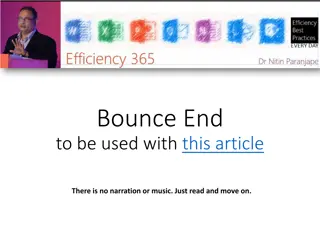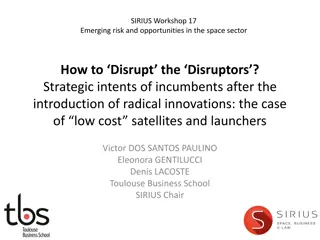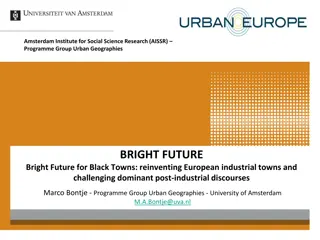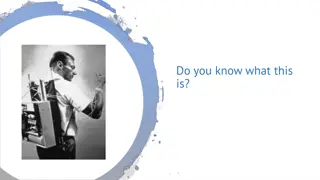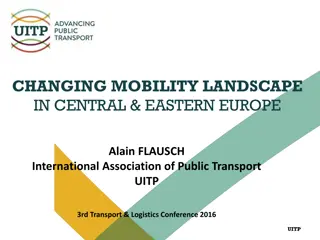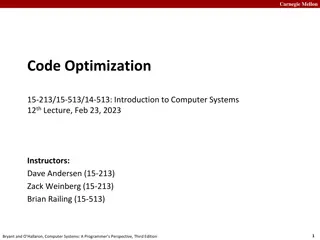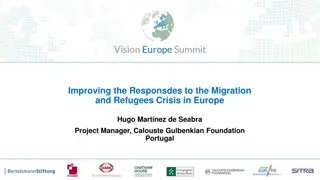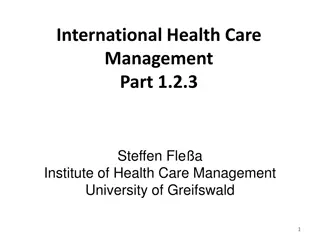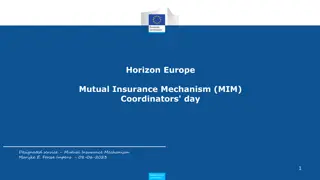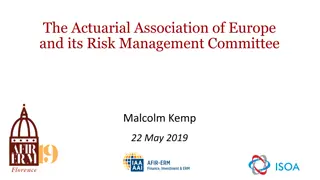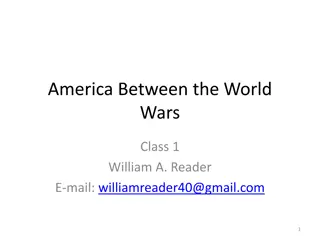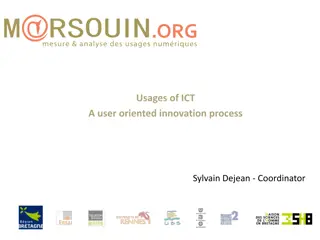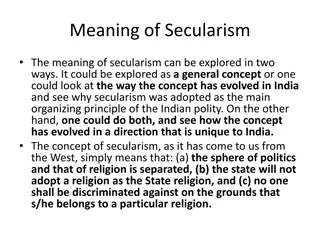Evolution of Animation in Europe: Pioneers and Innovations
Animation in Europe faced challenges in attaining industrial force, yet notable figures like Hans Richter, Walther Ruttmann, and Viking Eggeling made significant contributions through artistic experiments and abstract films. Richter, a Cubist painter, co-founded Dadaism and produced iconic works such as "Rhythmus 21" and "Filmstudie." Ruttmann, with a background in architecture and fine arts, added to the European animation landscape with his unique artistic vision.
Download Presentation

Please find below an Image/Link to download the presentation.
The content on the website is provided AS IS for your information and personal use only. It may not be sold, licensed, or shared on other websites without obtaining consent from the author. Download presentation by click this link. If you encounter any issues during the download, it is possible that the publisher has removed the file from their server.
E N D
Presentation Transcript
History of Animation Second Cycle Degree in Theatre, Film, Television and Media Studies Academic Year 2018-2019 Lesson 15
Animation in Europe 1 . In Europe the animated cartoon has never attained the slightest industrial force. Except for old German publicity films and some Russian cartoons, there has never been the continuous production necessary for future development . Joseph-Marie Lo Duca, 1948, quoted in Donald Crafton, Before Mickey. The animated film 1898-1928, The University of Chicago Press, Chicago, 1993, p. 217.
Animation in Europe 1 Germany Hans Richter (1888-1976) Walther Ruttmann (1887-1941) Viking Eggeling (1880-1925) Lotte Reininger (1899-1981) Oskar Fischinger (1900-1967)
Animation in Europe 1 Germany Hans Richter A Cubist painter; he later co-founded Dadaism in Zurich; he studied counterpoint with Ferruccio Busoni; with Swedish painter Viking Eggeling, he started a series of artistic experiments, first in Switzerland, later in Germany.
Animation in Europe 1 Germany Hans Richter His main contribution to European animation was the series of three abstract films Rhythmus 21, Rhythmus 23 and Rhythmus 25 (1921-1925). Later, he started experimenting with a mixture of animation and live-action (Filmstudie, 1926). He would use only live-action, or just tricks , in his later films (Vormittaggsspuk, 1927-28; Rennsymphonie, 1929; Dreams That Money Can Buy, 1947). He emigrated to the USA in 1940, after a rather obscure period as an advertising filmmaker.
Animation in Europe 1 Germany Rhythmus 21 (Hans Richter, 1921)
Animation in Europe 1 Germany Rhythmus 23 (Hans Richter, 1923)
Animation in Europe 1 Germany Filmstudie (Hans Richter, 1926)
Animation in Europe 1 Germany Vormittagsspuk (Hans Richter, 1927- 28)
Animation in Europe 1 Germany Walther Ruttmann A student of architecture in Zurich, of Fine Arts in Munich and a cellist; after World War I he started to put into practice his theories about painting with time ; his Lichtspiel Opus I (1921) had a successful debut in Berlin. Three more Opus followed.
Animation in Europe 1 Germany Walther Ruttmann He collaborated with Fritz Lang on Die Nibelungen (Part One), for the sequence of Kriemhild s nightmare; he also did a nightmare sequence for Paul Wegener s Lebende Buddhas (1923); he joined Lotte Reininger s team, at work on Die Abenteuer des Prinzen Achmed (1926); later, he realized that he desired to link the music of images with history
Animation in Europe 1 Germany Walther Ruttmann The result of the new aesthetics conceived by Ruttman was an innovative film genre: the citysymphony ; Berlin, Die Sinfonie der Gro stadt (1927) starts with 30 seconds of abstract animation: a kind of farewell to his previous aesthetics. He later created Melodie der Welt (1929); in 1933, Ruttmann went to Italy for the shooting of Acciaio, based on a text by Luigi Pirandello; he died in Berlin in 1941, because of the wounds he suffered as a war photographer.
Animation in Europe 1 Germany Lichtspiel Opus I (Walther Ruttmann, 1921)
Animation in Europe 1 Germany Lichtspiel Opus 2 (Walther Ruttmann, 1922)
Animation in Europe 1 Germany Lichtspiel Opus 3 (Walther Ruttmann, 1924)
Animation in Europe 1 Germany Lichtspiel Opus 4 (Walther Ruttmann, 1925)
Animation in Europe 1 Germany Berlin, Die Sinfonie der Gro stadt (Walther Ruttmann, 1929)
Animation in Europe 1 Germany Viking Eggeling He left Sweden to study in Germany, Switzerland, Italy and France; he befriended Richter and started working on visualmusic ; after the unfinished Horizontal-Vertikal Orchestra he planned the Diagonal Symphonie; filming started in summer 1923; finally, the film received support from UFA (Universum Film-Aktien Gesellschaft) and was included in a May 3, 1925 screening, featuring works by Richter, Ruttmann, Fernand L ger and Ren Clair; Eggeling did not attend the show, as he died of septic angina on May 9, 1925.
Animation in Europe 1 Germany Diagonal Symphonie (Viking Eggeling, 1925)
Animation in Europe 1 Germany Lotte Reininger 1919: she attends a lecture by Paul Wegener and learns about trickfilms ; she studies at Max Reinhardt s acting school; she starts cutting out silhouettes for stage plays; 1918: she does the captions for Der Rattenf nger von Hamelin (Paul Wegener, 1918); 1919: Wegener introduces her to a group of artists and animators: Hans C rlis, Carl Koch, Berthold Bartosch; she creates her first silhouette film, Das Ornament des verliebten Herzens.
Animation in Europe 1 Germany Lotte Reininger 1923: a proposal for a full-length film from a young Berlin banker, Louis Hagen; a studio was set up in Hagen s garage, near his house in Potsdam; Carl Koch (now Reininger s husband), Berthold Bartosch and Walter Ruttmann joined the production; Ruttmann created the background scenery, while Reininger filmed the action using silhouettes; Die Abenteuer des Prinzen Achmed, the first European full-length animate film, was finished in 1926; She kept directing silhouette films in Germany, Italy and Great Britain.
Animation in Europe 1 Germany Die Abenteuer des Prinzen Achmed (Lotte Reininger, 1926)
Animation in Europe 1 Germany The Star of Bethlehem (Lotte Reininger, 1956)
Animation in Europe 1 France Ladislas Starewich (1882-1965) Berthold Bartosch (1893-1968)
Animation in Europe 1 France Ladislas Starewich He was born in Moscow from a Polish family; his early interest for entomology and a film by mile Cohl lead him to cinema; his 1910-1919 production deals both with stop- motion animation and live-action films; in 1919 he moves to Fontenay-Sous-Bois, near Paris; he started an exclusively animated production, inspired by fables.
Animation in Europe 1 France Ladislas Starewich 1930: Le roman de renard, a full-length puppet film; it was sonorized and screened in Berlin in 1937, and finally released in France in 1941; Starewich s art was received with mixed reviews and appreciations; Starewich received negative criticism, mainly due to his exaggerated lyricism and extremely slow action. Overall, an extensive analysis of his work [ ] confirms this sense of contradiction, even if his originality is irrefutable . Bendazzi, Cartoons, p. 38.
Animation in Europe 1 France Miest Kinomatograficheskovo Operatora (Ladislas Starewich, 1911)
Animation in Europe 1 France Le roman de renard (Ladislas Starewich, 1930)
Animation in Europe 1 France Berthold Bartosch He was born in Austrian Bohemia; he studied Architecture and Fine Arts in Vienna, with Prof. Hanslick, who suggested him to produce educational films; he was a self-taught filmmaker; he learnt more about animation by working with Lotte Reininger in Berlin; In 1929, publisher Kurt Wolff asked Bartosch to create an animation based on an illustrated storybook by Frans Masereel; Bartosch moved to Paris and started his work.
Animation in Europe 1 France Berthold Bartosch In order to create the depth of field which is not offered by simple drawings, he placed the motion picture camera vertically above a working surface formed by several levels of glass plates. On each of them he would arrange scenographic elements or cut-out figures with the illumination coming from below. In an attempt to soften the hard lines of the drawings and the rigidity of the animation, he created a muffled, opalescent atmosphere by blurring the glass plates with common soap, while also making frequent use of superimposition . Bendazzi, Cartoons, p. 38.
Animation in Europe 1 France Berthold Bartosch L Id e was completed in 1931; it retained little of Masereel s book; It was never released, but the few who saw it highly appreciated it; English critic Thorold Dickinson offered Bartosch financial help for the creation of a new film; a colour anti-war film was started; it was entitled Cauchemar, or Saint Fran ois, and it was to be released with music by Arthur Honegger; The film was destroyed during World War II; Bartosch later planned a third work about the cosmos and light, but he never filmed it.
Animation in Europe 1 France L Id e (Berthold Bartosch, 1931)
Suggested readings Giannalberto Bendazzi, Animation. A World History. 3 voll., Waltham, Massachusetts: Focal Press, 2015. Vol. I, pp. 55-65 (from and including- the section Germany: Animation in the Weimar Republic up to and including- the section Lotte Reininger ). Vol. I, pp. 72-75 (only the section Ladislas Starewich ); Vol. II, pp. 46-48 (only the section Ladislas Starewich and the Feature Film). Vol. I, pp. 138-140 (only the section BertholdBartosch ).




